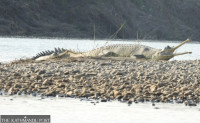National
Human-animal conflict rises in Dolakha’s Lapchi area
Villagers say bears and snow leopards have been damaging crops and killing their cattle.
Kedar Shiwakoti
Local people of Lapchi village, which lies in ward 1 of Bigu Rural Municipality near the Nepal-China border in Dolakha district, have a tough time protecting their domesticated animals and food grains from Himalayan black bears.
Bears, rarely sighted at Lapchi in the past, now show up in the area frequently and wreak havoc. The phenomenon has been on the rise since the past couple of years. “We are now worried to keep ourselves safe and protect our domesticated animals as well as food grains from the bears,” said Tenjing Sherpa, a local from Lapchi village.
According to Tenjing, the locals of Lapchi migrate to lower altitude places every year around mid-November to escape cold. “The villagers descend to Lumnang of Bigu-1 and find pastures for yaks. It is during this time the bears enter the settlement and destroy the food grains stored in the houses,” said Tenjing.
Lapchi is a remote village that borders Tibet of China. The locals have to walk for nearly two days to reach Lamabagar, the nearest market in Nepal, to buy daily essentials. They are dependent on the Tibetan market to sell the local products and buy the essentials.
Lapchi locals rear yaks and produce yak milk products to sell in the Tibetan markets across the border. They had been unable to sell their goods in the Tibetan market as the border had remained closed since 2019 due to Covid pandemic. They have heaved a sigh of relief after the Chinese authorities eased cross-border movement for the residents of Lapchi since September 30.
“We have managed some food grains from the Tibetan market after the Chinese government opened the border,” said Karma Sherpa, another local of Lapchi. “All the villagers, except some old people, are in the village now. The bears barge into the houses, eat and damage the good grains stored.” There are two bears in particular that frequently enter the village and incur damage, according to Karma.
“The bears generally break the stone walls of empty houses and eat up the grains,” Karma added. “The bears broke as many as 17 houses in the village this year. The old people who vigil the village now are in abject terror fearing that the bears may attack people as well.”
There are currently 46 households with around 150 people in Lapchi. They eke out a living mainly by rearing yaks and horses. They sell live yaks, ghee, chhurpi (hardened cheese) in the Tibetan market for livelihood.
“We have been living in hardships in recent times. The bears break the houses and eat food grains while the bears as well as snow leopards kill calves of the yaks and horses,” said Lakpa Sherpa, another local. He informed that the wildlife attacks surged in the settlement from last year.
The local people of Lapchi complain that the authorities concerned neither take any initiatives to protect the village from the wild animals nor provide compensation to the victims.
According to Mem Bahadur Tamang, ward chairman of Bigu-1, many complaints regarding the damage and destruction of properties by wild animals are registered at the ward office every year. “Efforts are on to coordinate with Gaurishankar Conservation Area and provide compensation to the victims,” said Mem Bahadur.
Human-animal conflict is on the rise in the Gaurishankar Conservation Area in recent years. “The conflict increased mainly due to human encroachment,” said Tulasi Prasad Dahal, information officer at the conservation area. “A hydropower project is under construction in the area now. Many trees are felled down while an access road is being constructed. Such construction activities frighten the animals so they enter the human settlements.” According to Dahal, 12 applications have been registered at the conservation area office this year stating that the bears broke into the house and ate food grains.
Of late, the population of various wild animals including snow leopard and bear has increased in the Gaurishankar Conservation Area. A snow leopard and its baby were recently captured in a camera trap in the area.
“The conservation area provides compensation to the affected people but it does not solve the ongoing human-animal conflict,” Dahal said. “We are holding talks with the locals to protect the animals’ habitats for the sustainable solution of the problem.”




 7.12°C Kathmandu
7.12°C Kathmandu















